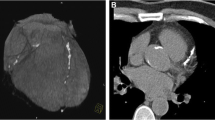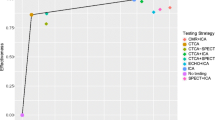Abstract
To determine if calcium scores (CS) could act as a more effective gatekeeper than Diamond Forrester (DF) in the assessment of patients with suspected coronary artery disease (CAD). A sub-study of the Cardiac CT for the Assessment of Chest Pain and Plaque (CAPP) study, a randomised control trial evaluating the cost-effectiveness of cardiac CT in symptomatic patients with stable chest pain. Stable pain was defined as troponin negative pain without symptoms of unstable angina. 250 patients undergoing cardiac CT had both DF scores and CS calculated, with the accuracy of both evaluated against CT coronary angiogram. Criteria given in UK national guidelines were compared. Of the 250 patients, 4 withdrew. 140 (57 %) patients were male. The mean DF was 47.8 and mean CS 172.5. Of the 144 patients with non-anginal pain 19.4 % had significant disease (>50 % stenosis). In general the DF over estimated the presence of CAD whereas the CS reclassified patients to lower risk groups, with 91 in the high risk DF category compared to 26 in the CS. Both receiver operating curve and McNemar Bowker test analysis suggested the DF was less accurate in the prediction of CAD compared to CS \( (\chi^{2} = 51.57,\;df = 3,\; p \; {\text{value}} < 0.0001). \) Projected downstream investigations were also calculated, with the cost per number of significant stenoses identified cheaper with the CS criteria. Patients with suspected stable CAD are more accurately risk stratified by CS compared to the traditional DF. CS was more successful in the prediction of significant stenosis and appears to be more effective at targeting clinical resources to those patients that are in need of them.



Similar content being viewed by others
References
Skinner JS, Smeeth L, Kendall JM, Adams PC, Timmis A (2010) NICE guidance. Chest pain of recent onset: assessment and diagnosis of recent onset chest pain or discomfort of suspected cardiac origin. Heart 96:974–978
Taylor AJ, Cerqueira M, Hodgson JM, Mark D, Min J, O’Gara P et al (2010) ACCF/SCCT/ACR/AHA/ASE/ASNC/NASCI/SCAI/SCMR 2010 appropriate use criteria for cardiac computed tomography: a report of the American College of Cardiology Foundation Appropriate Use Criteria Task Force, the Society of Cardiovascular Computed Tomography, the American College of Radiology, the American Heart Association, the American Society of Echocardiography, the American Society of Nuclear Cardiology, the North American Society for Cardiovascular Imaging, the Society for Cardiovascular Angiography and Interventions, and the Society for Cardiovascular Magnetic Resonance. J Am Coll Cardiol 56:1864–1894
Diamond GA, Forrester JS (1979) Analysis of probability as an aid in the clinical diagnosis of coronary-artery disease. N Engl J Med 300:1350–1358
Agatston AS, Janowitz WR, Hildner FJ, Zusmer NR, Viamonte M Jr, Detrano R (1990) Quantification of coronary artery calcium using ultrafast computed tomography. J Am Coll Cardiol 15:827–832
Villines TC, Taylor AJ (2012) Multi-ethnic study of atherosclerosis arterial age versus Framingham 10-year or lifetime cardiovascular risk. Am J Cardiol 110(11):1627–1630
Schmermund A, Möhlenkamp S, Stang A, Grönemeyer D, Seibel R, Hirche H et al (2002) Assessment of clinically silent atherosclerotic disease and established and novel risk factors for predicting myocardial infarction and cardiac death in healthy middle-aged subjects: rationale and design of the Heinz Nixdorf RECALL Study. Risk Factors, Evaluation of Coronary Calcium and Lifestyle. Am Heart J 144:212–218
Kennedy J, Shavelle R, Wang S, Budoff M, Detrano RC (1998) Coronary calcium and standard risk factors in symptomatic patients referred for coronary angiography. Am Heart J 135:696–702
Greenland P, Bonow RO, Brundage BH, Budoff MJ, Eisenberg MJ, Grundy SM et al (2007) ACCF/AHA 2007 clinical expert consensus document on coronary artery calcium scoring by computed tomography in global cardiovascular risk assessment and in evaluation of patients with chest pain: a report of the American College of Cardiology Foundation Clinical Expert Consensus Task Force (ACCF/AHA Writing Committee to Update the 2000 Expert Consensus Document on Electron Beam Computed Tomography). Circulation 115:402–426
Hwang Y, Kim Y, Chung IM, Ryu J, Park H (2010) Coronary heart disease risk assessment and characterization of coronary artery disease using coronary CT angiography: comparison of asymptomatic and symptomatic groups. Clin Radiol 65:601–608
Villines TC, Hulten EA, Shaw LJ, Goyal M, Dunning A, Achenbach S et al (2011) CONFIRM Registry Investigators. Prevalence and severity of coronary artery disease and adverse events among symptomatic patients with coronary artery calcification scores of zero undergoing coronary computed tomography angiography: results from the CONFIRM (Coronary CT Angiography Evaluation for Clinical Outcomes: an International Multicenter) registry. J Am Coll Cardiol 58:2533–2540
Mollet NR, Cademartiri F, van Mieghem CA, Runza G, McFadden EP, Baks T et al (2005) High-resolution spiral computed tomography coronary angiography in patients referred for diagnostic conventional coronary angiography. Circulation 112:2318–2323
Raff GL, Gallagher MJ, O’Neill WW, Goldstein JA (2005) Diagnostic accuracy of noninvasive coronary angiography using 64-slice spiral computed tomography. J Am Coll Cardiol 46:552–557
Kuettner A, Kopp AF, Schroeder S, Rieger T, Brunn J, Meisner C et al (2004) Diagnostic accuracy of multidetector computed tomography coronary angiography in patients with angiographically proven coronary artery disease. J Am Coll Cardiol 43:831–839
Cademartiri F (2006) Is calcium the key for the assessment of progression/regression of coronary artery disease? Heart 92:1187–1188
National Institute for Health and Clinical Excellence (2011) Chest pain of recent onset: costing report. Available online: http://www.nice.org.uk/nicemedia/live/12947/55738/55738.pdf
Patterson C, Nicol E, Bryan L, Woodcock T, Collinson J, Padley S (2011) The effect of applying NICE guidelines for the investigation of stable chest pain on out-patient cardiac services in the UK. QJM 104:581–588
Garg P, Ashrafi R, Feeney L, Lagan J, Wong P, Rodrigues E et al (2011) Impact on service provision for non-invasive cardiac imaging following NICE recommendations: an observational study. Postgrad Med J 87:445–449
Dougan JP, Mathew TP, Riddell JW, Spence MS, McGlinchey PG, Nesbitt GS et al (2001) Suspected angina pectoris: a rapid-access chest pain clinic. QJM 94:679–686
Abidov A, Rozanski A, Hachamovitch R, Hayes SW, Aboul-Enein F, Cohen I et al (2005) Prognostic significance of dyspnea in patients referred for cardiac stress testing. N Engl J Med 353:1889–1898
Berlinerblau R, Shani J (1994) Postprandial angina pectoris: clinical and angiographic correlations. J Am Coll Cardiol 23:627–629
Wasfy MM, Brady TJ, Abbara S, Nasir K, Ghoshhajra BB, Truong QA et al (2012) Comparison of the Diamond-Forrester method and duke clinical score to predict obstructive coronary artery disease by computed tomographic angiography. Am J Cardiol 109:998–1004
Versteylen MO, Joosen IA, Shaw JL, Narula J, Hofstra L (2011) Comparison of Framingham, PROCAM, SCORE, and Diamond Forrester to predict coronary atherosclerosis and cardiovascular events. J Nucl Cardiol 18:904–911
Hadamitzky M, Freissmuth B, Meyer T, Hein F, Kastrati A, Martinoff S et al (2009) Prognostic value of coronary computed tomographic angiography for prediction of cardiac events in patients with suspected coronary artery disease. J Am Coll Cardiol Cardiovasc Imaging 2:404–411
Cheng V, Berman DS, Dunning A, Achenbach S, Al-Mallah M, Budoff MJ et al (2010) Abstract 12100: marked overestimation of obstructive coronary artery disease probability by the Diamond-Forrester classification in symptomatic patients undergoing coronary CT angiography: results from the multinational CONFIRM Registry (Coronary CT Angiographic Evaluation For Clinical Outcomes: an International Multicenter Registry). Circulation 122(Suppl):12100
Genders TS, Steyerberg EW, Alkadhi H, Leschka S, Desbiolles L, Nieman K et al (2011) A clinical prediction rule for the diagnosis of coronary artery disease: validation, updating, and extension. Eur Heart J 32:1316–1330
Jensen JM, Voss M, Hansen VB, Andersen LK, Johansen PB, Munkholm H et al (2012) Risk stratification of patients suspected of coronary artery disease: comparison of five different models. Atherosclerosis 220:557–562
Schmermund A, Denktas AE, Rumberger JA, Christian TF, Sheedy PF 2nd, Bailey KR et al (1999) Independent and incremental value of coronary artery calcium for predicting the extent of angiographic coronary artery disease: comparison with cardiac risk factors and radionuclide perfusion imaging. J Am Coll Cardiol 34:777–786
Budoff MJ, Diamond GA, Raggi P, Arad Y, Guerci AD, Callister TQ et al (2002) Continuous probabilistic prediction of angiographically significant coronary artery disease using electron beam tomography. Circulation 105:1791–1796
van Kempen BJ, Spronk S, Koller MT, Elias-Smale SE, Fleischmann KE, Ikram MA et al (2011) Comparative effectiveness and cost-effectiveness of computed tomography screening for coronary artery calcium in asymptomatic individuals. J Am Coll Cardiol 58:1690–1701
Sarwar A, Shaw LJ, Shapiro MD, Blankstein R, Hoffmann U, Cury RC et al (2009) Diagnostic and prognostic value of absence of coronary artery calcification. J Am Coll Cardiol Cardiovasc Imaging 2:675–688
Genders TS, Pugliese F, Mollet NR, Meijboom WB, Weustink AC, van Mieghem CA et al (2010) Incremental value of the CT coronary calcium score for the prediction of coronary artery disease. Eur Radiol 20:2331–2340
Haberl R, Becker A, Leber A, Knez A, Becker C, Lang C et al (2001) Correlation of coronary calcification and angiographically documented stenoses in patients with suspected coronary artery disease: results of 1,764 patients. J Am Coll Cardiol 37:451–457
Knez A, Becker A, Leber A, White C, Becker CR, Reiser MF et al (2004) Relation of coronary calcium scores by electron beam tomography to obstructive disease in 2,115 symptomatic patients. Am J Cardiol 93:1150–1152
Marwan M, Mettin C, Pflederer T, Seltmann M, Schuhbäck A, Muschiol G et al (2013) Very low-dose coronary artery calcium scanning with high-pitch spiral acquisition mode: comparison between 120-kV and 100-kV tube voltage protocols. J Cardiovasc Comput Tomogr 7(1):32–38
National Institute for Health and Clinical Excellence. Chest pain of recent onset. CT calcium scoring factsheet. Available online: http://www.nice.org.uk/nicemedia/live/12947/47987/47987.pdf
Ostrom MP, Gopal A, Ahmadi N, Nasir K, Yang E, Kakadiaris I et al (2008) Mortality incidence and the severity of coronary atherosclerosis assessed by computed tomography angiography. J Am Coll Cardiol 52:1335–1343
Conflict of interest
None.
Author information
Authors and Affiliations
Corresponding authors
Rights and permissions
About this article
Cite this article
McKavanagh, P., Lusk, L., Ball, P.A. et al. A comparison of Diamond Forrester and coronary calcium scores as gatekeepers for investigations of stable chest pain. Int J Cardiovasc Imaging 29, 1547–1555 (2013). https://doi.org/10.1007/s10554-013-0226-6
Received:
Accepted:
Published:
Issue Date:
DOI: https://doi.org/10.1007/s10554-013-0226-6




